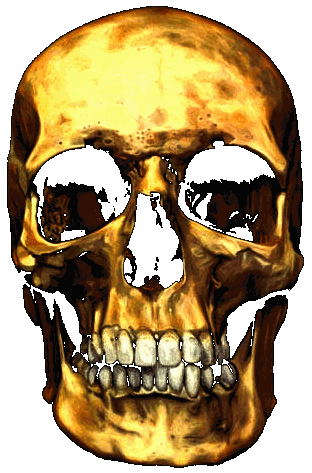|
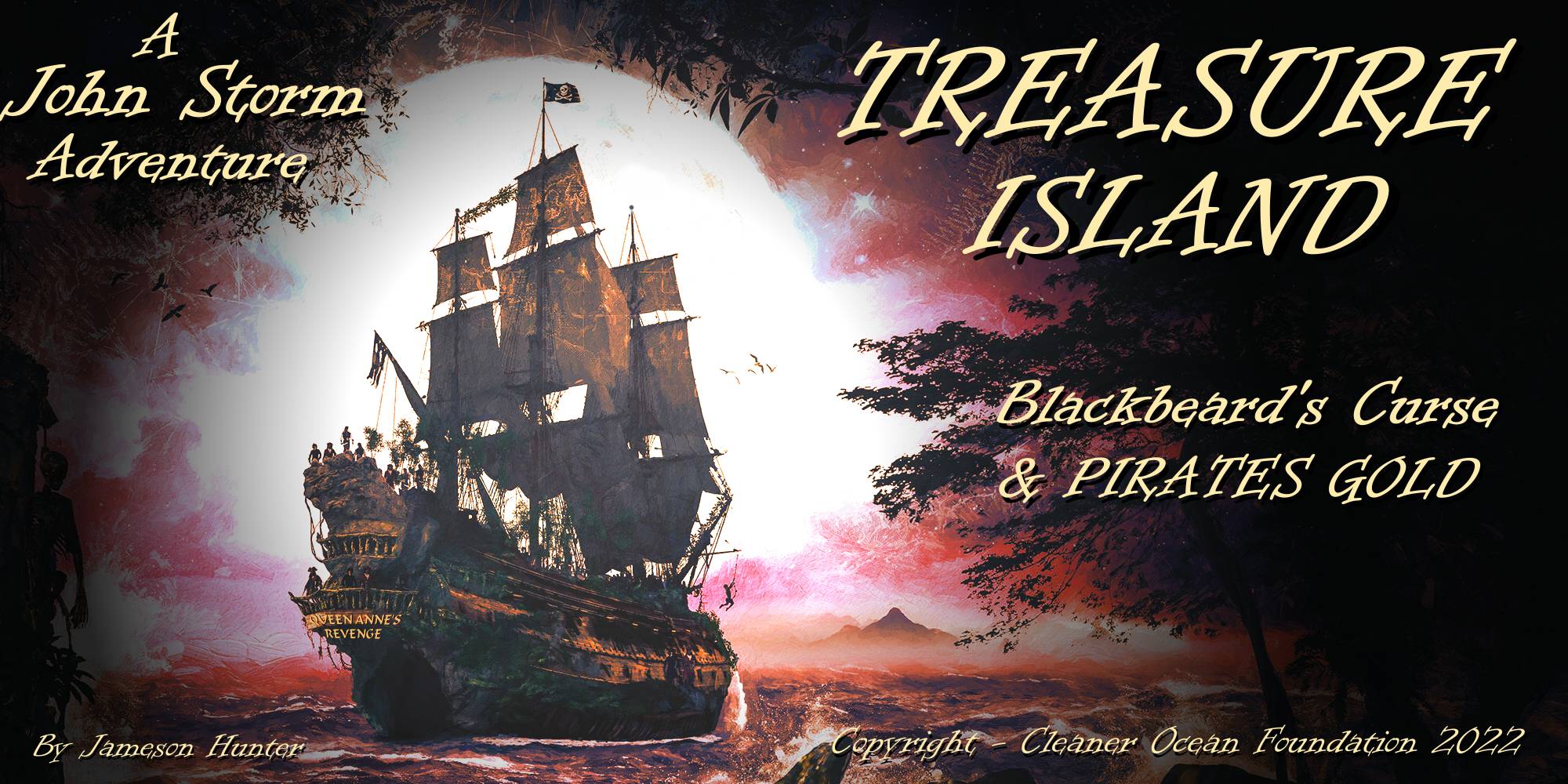
One man has been guarding the
existence of a parchment that contains clues to the location of Edward Teach's secret treasure trove on an Island in the Caribbean, said to be guarded by a macabre human spirit manifesting itself with a golden human skull.
The
original Treasure Island was written by Robert Louis
Stevenson. He set the
benchmark for pirates and treasure hunts based on an old map. He inspired us to
attempt a modern take on his classic, based on the interesting
inconsistency, that nobody has yet discovered the whereabouts of either
Henry Morgan's or Blackbeard's treasure troves, from their years of piracy on the high seas. That
strange anomaly, coupled with the fact that pirates were known to hide their
gold and silver stashes by burying in unmarked locations, leaving maps that
only they could read. Leaves us to conclude that there is a substantial find
to be made - even though our tale is fictional - something very close, could
well be true.
Compare
our story with the Top
Ten movies so far.
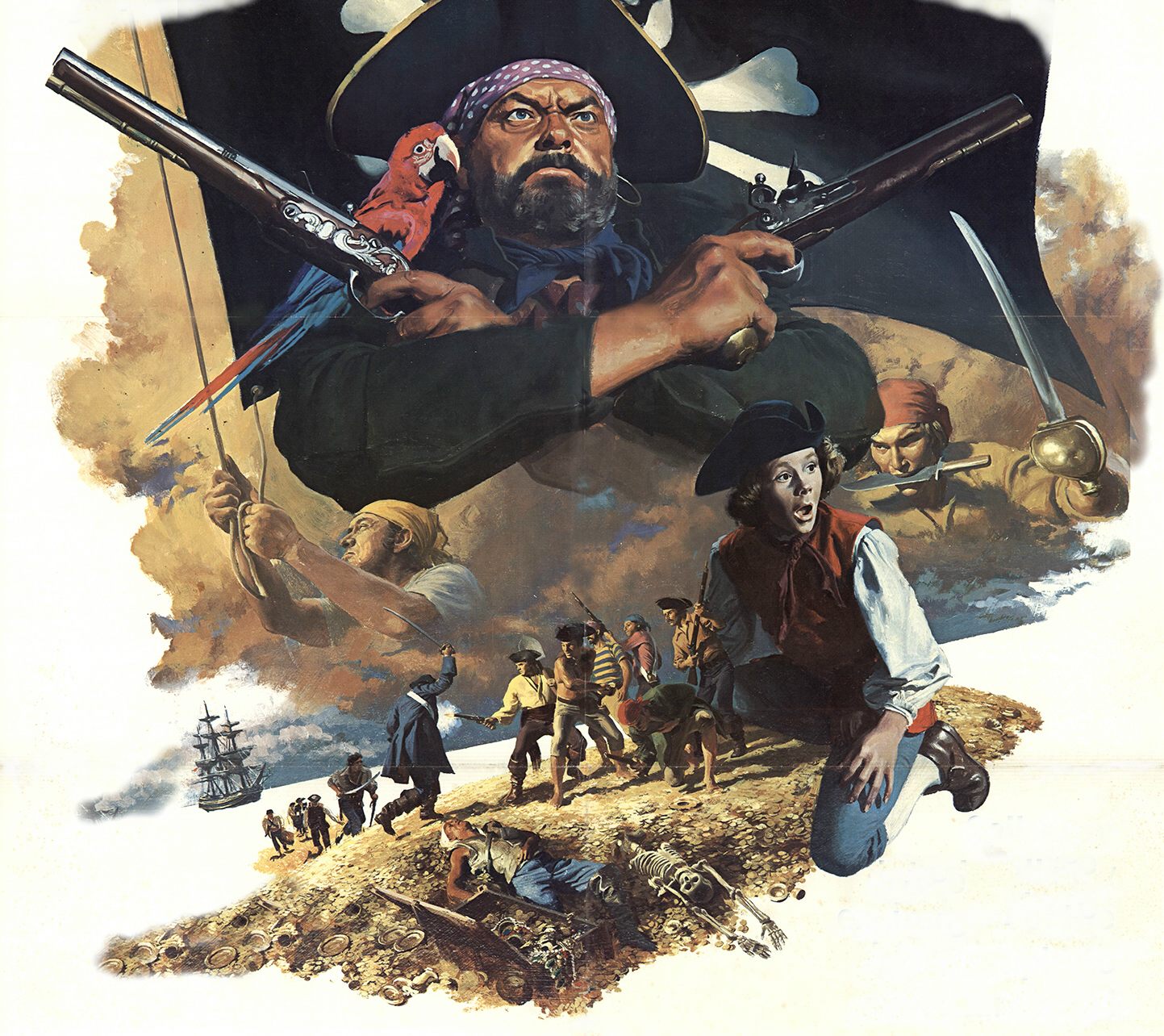
THE
SEA COOK - A STORY FOR BOYS (TREASURE ISLAND)
Treasure Island (originally titled The Sea Cook: A Story for Boys) is an adventure novel by Scottish author
Robert Louis
Stevenson, telling a story of "buccaneers and
buried
gold". It is considered a coming-of-age story and is noted for its atmosphere, characters, and action.
The novel was originally serialised from 1881 to 1882 in the children's magazine Young Folks, under the title Treasure Island or the Mutiny of
the Hispaniola, credited to the pseudonym "Captain George North". It was first published as a book on 14 November 1883 by Cassell & Co. It has since become one of the most often dramatized and adapted of all novels, in numerous media.
Since its publication, Treasure Island has had significant influence on depictions of pirates in popular culture, including elements such as deserted tropical islands, treasure maps marked with an "X", and one-legged seamen with parrots perched on their shoulders.
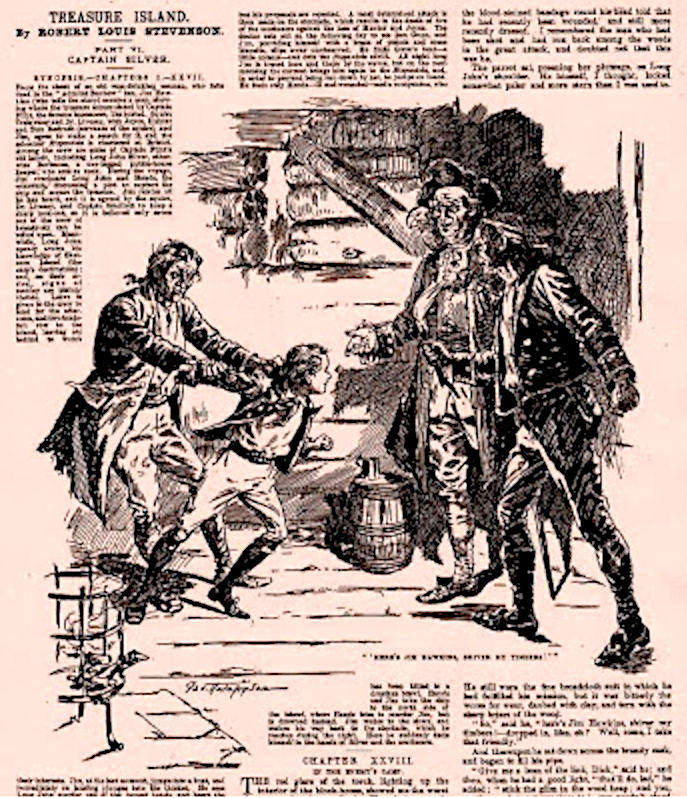
PLOT
The plot is set in the mid-18th century, when an old sailor who identifies himself as "The Captain" starts to lodge at the rural Admiral Benbow Inn on England's Bristol Channel. He tells the innkeeper's son, Jim Hawkins, to keep a lookout for "a one-legged seafaring man". A former shipmate named Black Dog confronts The Captain about a chart. They get into a violent fight, causing Black Dog to flee. The Captain, proper name Billy Bones, suffers a stroke. That night, Jim's father dies suddenly. A few days later, a blind beggar named Pew visits the inn, delivering a summons to Bones called "the black spot". Shortly thereafter, Bones suffers another stroke and dies. Pew and his accomplices attack the inn, but are routed by excise officers, and Pew is trampled to death. Jim and his mother escape with a mysterious packet from Bones' sea chest, which is found to contain a map of the island on which the infamous pirate Captain Flint hid his treasure. Jim shows the map to the local physician Dr. Livesey and the squire John Trelawney, and they decide to make an expedition to the island, with Jim serving as a cabin boy.
They set sail on Trelawney's schooner, the Hispaniola, under Captain Smollett and Jim forms a strong bond with the ship's one-legged cook, Long John Silver. The crew suffers tragedy when first mate Mr. Arrow, a drunkard, is washed overboard during a storm. While hidden in an apple-barrel, Jim overhears a conversation among the Hispaniola's crew which reveals that many of them are pirates who had served on Captain Flint's ship, the Walrus, with Silver leading them. They plan to mutiny after the salvage of the treasure, and to murder the captain and the few remaining loyal crew.
Arriving at the island, Jim joins the shore party and they begin to explore. He meets a marooned pirate named Ben Gunn, who is also a former member of Flint's crew. The mutineers arm themselves and take the ship while Smollett's loyal men take refuge in an abandoned stockade on the island. After a brief truce, the mutineers attack them, with casualties on both sides of the battle. Jim makes his way to the Hispaniola and cuts the ship from its anchor, drifting it along the ebb tide. He boards the ship and encounters the pirate Israel Hands, who had been injured in a drunken dispute with one of his companions. Hands helps Jim beach the schooner in the northern bay, then attempts to kill Jim with a knife, but Jim shoots him dead with two pistols.
Jim goes ashore and returns to the stockade, where he is horrified to find only Silver and the pirates. Silver tells Jim that when everyone found the ship was gone, Captain Flint's party had agreed to a truce whereby they take the map and allow the besieged party to leave. In the morning, Livesey arrives to treat the wounded and sick pirates and tells Silver to look out for trouble once he's found the site of the treasure. After a dispute over leadership, Silver and the others set out with the map, taking Jim along as a hostage. They find a skeleton with its arms oriented toward the treasure, unnerving the party. Scaring the crew, Ben Gunn shouts Captain Flint's last words from the forest, making the pirates believe that Flint's ghost is haunting the island. They eventually find the treasure cache, but it is empty. The pirates prepare to kill Silver and Jim, but they are ambushed by the officers along with Gunn. Livesey explains that Gunn had already found the treasure and taken it to his cave long ago. The expedition members load a portion of the treasure onto the Hispaniola and depart the island, with Silver as a prisoner. At their first port, in Spanish America, Silver steals a bag of money and escapes. The rest of them sail back to Bristol and divide up the treasure. Still, Jim says that there is more left on the island, but he will not undertake another voyage to claim it.
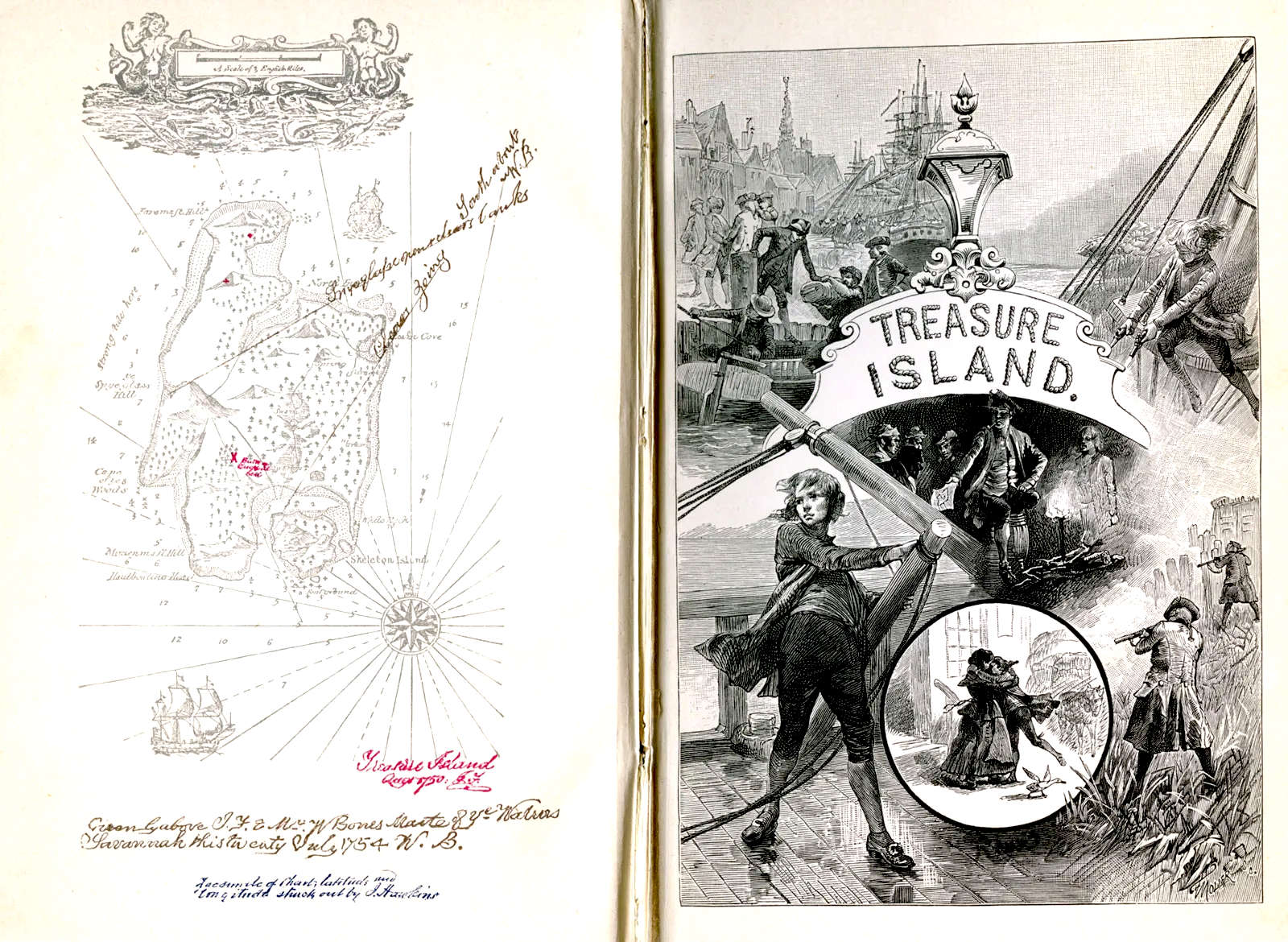
BACKGROUND
Stevenson conceived the idea for the novel based on a map of an imaginary, romantic island which he drew with his stepson Lloyd Osbourne, during a holiday in Braemar, Scotland in the summer of 1881. He had clearly started work by 25 August, writing to a friend, "If this don't fetch the kids, why, they have gone rotten since my day. Will you be surprised to learn that it is about Buccaneers, that it begins in the Admiral Benbow public house on the Devon coast, that it's all about a map and a treasure and a mutiny and a derelict ship... It's quite silly and horrid fun – and what I want is the best book about Buccaneers that can be had".
Stevenson originally gave the book the title The Sea Cook. One month after conceiving of the book, chapters began to appear in the pages of the Young Folks magazine. After completing fifteen or nineteen chapters rapidly, Stevenson was interrupted by illness; he left Scotland and continued working on the first draft near London, where he and his father discussed points of the tale, and his father suggested elements that he included. The novel eventually ran in seventeen weekly instalments from October 1, 1881, to January 28, 1882. The book was later republished as the novel Treasure Island and proved to be Stevenson's first financial and critical success. The Liberal politician William Ewart Gladstone, who served four terms as British Prime Minister between 1868 and 1894, was one of the book's biggest fans.
Two general types of sea novels were popular during the 19th century: the navy yarn, which places a capable officer in adventurous situations amid realistic settings and historical events, and the desert island romance, which features shipwrecked or marooned characters confronted by treasure-seeking pirates or angry natives. Around 1815, the latter genre became one of the most popular fictional styles in Great Britain, perhaps because of the philosophical interest in Rousseau and Chateaubriand's "noble savage". Treasure Island was a climax of this development.
The growth of the desert island genre can be traced back to 1719 when
Daniel Defoe's Robinson Crusoe was published. A century later, novels such as S. H. Burney's The Shipwreck (1816), and Sir Walter Scott's The Pirate (1822) continued to expand upon Defoe's classic. Other authors, in the mid-19th century, continued this trend, with works including James Fenimore Cooper's The Pilot (1823). During the same period, Edgar Allan Poe wrote "MS Found in a Bottle" (1833) and "The Gold-Bug" (1843). All of these works influenced Stevenson's end
product.
Stevenson also consciously borrowed material from previous authors. In a July 1884 letter to Sidney Colvin, he wrote that "Treasure Island came out of Kingsley's At Last, where I got the Dead Man's Chest—and that was the seed—and out of the great Captain Johnson's History of the Notorious Pirates". Stevenson also admits that he took the idea of Captain Flint's pointing skeleton from Poe's The Gold-Bug and he constructed Billy Bones' history from the "Money-Diggers" section ("Golden Dreams" in particular) of Tales of a Traveller by Washington Irving, one of his favorite writers.
Half of Stevenson's manuscripts are lost, including those of Treasure Island, The Black Arrow, and The Master of Ballantrae. Stevenson's heirs sold his papers during World War I; many of his documents were auctioned off in 1918.
CHARACTERS: MAIN
- Jim Hawkins: The narrator of most of the novel. Jim is the son of an innkeeper near Bristol, England, and appears to be in his mid-teens. He is eager to go to sea and hunt for treasure. Jim consistently displays courage and heroism, but is also sometimes impulsive and impetuous. He exhibits increasing sensitivity and wisdom as the journey progresses.
- Long John
Silver: The one-legged cook aboard the Hispaniola. Silver is the secret leader of the pirates. He is deceitful and greedy, but also charismatic, and his physical and mental strength are impressive. He is kind toward Jim and appears genuinely fond of him. Silver was based in part on Stevenson's friend and mentor William Ernest Henley.
- Dr. David Livesey: A doctor and magistrate; he narrates a few chapters of the novel. He exhibits common sense and rationality, and is fair-minded, treating wounded pirates just as he does his own comrades. Some years prior to the events of the novel, he had participated in the Battle of Fontenoy, during which he was wounded in action.
- Captain Alexander Smollett: The captain of the Hispaniola. He is savvy and is rightly suspicious of the crew that Trelawney hires. Smollett is a real professional, taking his job seriously and displaying skill as a negotiator. Smollett believes in rules and does not like Jim's disobedience, but later in the novel states that he and Jim shouldn't go to sea together again as Jim was too much of the born favourite for him.
- Squire John Trelawney: A wealthy landowner who arranges the voyage to the island. He is too trusting and is duped by Silver into hiring pirates as the ship's crew.
- Billy Bones: An old seaman who resides at the Admiral Benbow Inn. He used to be Flint's first mate, and is surly and rude. He exhorts Jim to be on the lookout for a one-legged man. A treasure map in his possession set the events of the novel in motion.
- Ben Gunn: A former member of Captain Flint's crew who was found on Treasure Island, having been marooned there by Flint's crew several years earlier. He is described as being "insane", at least partially, and has a craving for cheese.
In the semi-official prequel story Porto Bello Gold by Arthur D. Howden Smith, Ben Gunn was the servant of captain Andrew "Rip-Rap" Murray, Flint's associate and the mastermind behind the capture of the treasure ship Santissima Trinidad, whence the buried treasure was taken. Murray described Ben Gunn as a "half-wit" whom he kept as servant specifically because he considered him intellectually incapable of treachery. After Flint's crew killed Murray and overpowered his crew, Ben Gunn went to serve Flint and fled the Walrus in Savannah after Flint's death.
According to The Adventures of Ben Gunn, he was Nic Allardyce's servant and friend from back home.
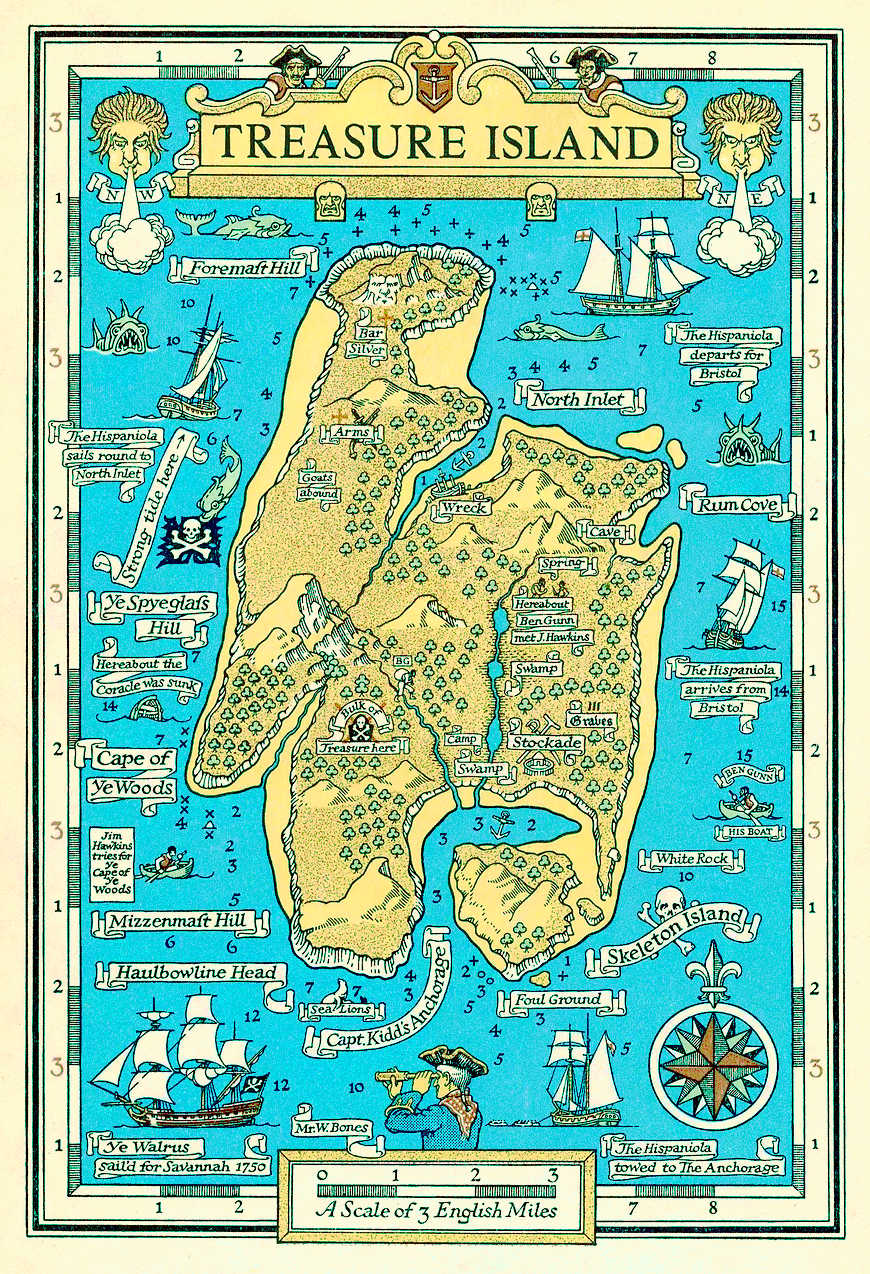
TREASURE
ISLAND - An embellished map from the original illustrated book by Robert
Louis Stevenson
CHARACTERS MINOR
- Alan: An honest sailor who is killed by the mutineers during the landing on the island and whose death scream is heard across the isle. The incident occurs just before Long John murders Tom.
- Allardyce: One of the six members of Flint's Crew who, after burying the treasure and silver and building the blockhouse on Treasure Island, are all killed by Flint, who returns to his ship alone. Allardyce's body is lined up by Flint as a compass marker to the cache.
In Porto Bello Gold, one sailor on Flint's ship is named "Tom Allardyce". A lanky fellow with rather long, yellow hair, he is an antagonistic ringleader of sailors opposing Flint in at least two "fo'c'sle councils". Flint thinks they may present him with the Black Spot; he eventually challenges Allardyce to bring six friends and bury the treasure together.
According to The Adventures of Ben Gunn, his first name was "Nic", he was surgeon on Flint's crew, and Ben Gunn was his servant and friend from back home.
- Job Anderson: The ship's boatswain and one of the leaders of the mutiny. He participates in the storming of the blockhouse and is killed by Gray while attacking Jim. He is probably one of Flint's old pirate hands, though this is never stated. Along with Hands and Merry, he tipped a Black Spot on Silver and forced Silver to start the mutiny before the treasure was found.
- Mr. Arrow: The first mate of the Hispaniola. He is an alcoholic and is useless as a first mate. He disappears before they get to the island and his position is filled by Job Anderson. Silver had secretly given Mr. Arrow alcohol and he fell drunkenly overboard on a stormy night. In his BBC adaptation of 1977, John Lucarotti gives him the first name "Joshua". His first name was not stated in the novel.
- Black Dog: Formerly a member of Flint's pirate crew, later one of Pew's companions who visits the Admiral Benbow to confront Billy Bones. He is spotted by Jim in Silver's tavern and slips out to be chased by two of Silver's men (in order to maintain the ruse that Silver and his men are not associated with him). Two fingers are missing from his left hand.
- Pew: A vicious, deadly, and sinister blind beggar who served as a member of Flint's crew. Despite his blindness, he proves to be a dangerous adversary and can even be considered a ringleader amongst his fellow crewmen. He is the second messenger to approach Billy Bones and the one to deliver the
Black Spot. He is trampled to death by the horses of revenue officers riding to assist Jim and his mother after the raid on their inn. Silver claims Pew spent his share of Flint's treasure at a rate of £1,200 per year, and that for two years until his accident at the
"Admiral Benbow", he begged, stole, and murdered. Stevenson avoided predictability by making the two most fearsome characters a blind man and an amputee. In the play Admiral Guinea (1892), Stevenson gives him the full name "David Pew". Stevenson's novel Kidnapped (1886) also features a dangerous blind man.
In Porto Bello Gold, it is Pew who fatally stabs captain Murray, working in concert with Long John Silver. From the context, it seems that Silver means Pew when he addresses one man as "Ezra" just prior.
- Mr. Dance: Chief revenue officer (titled Supervisor) who ascends with his men upon the Admiral Benbow, driving out the pirates, and saving Jim Hawkins and his mother. He then takes Hawkins to see the squire and the doctor.
Dogger: One of Mr. Dance's associates, who doubles Hawkins on his horse to the squire's house.
- Captain J.
Flint: A pirate who was captain of a ship called the Walrus, and who is dead before the events of the novel begin. In life he was the leader of the pirates and they refer to him often. He was the original possessor of the treasure, and buried it on the island. Long John Silver's
parrot is named after him.
- Abraham
Gray: A ship's carpenter's mate on the Hispaniola. He is almost incited to mutiny but remains loyal to the Squire's side when asked to do so by Captain Smollett. He saves Hawkins' life by killing Job Anderson during an attack on the stockade, and he helps shoot the mutineers at the rifled treasure cache. He later escapes the island together with Jim Hawkins, Dr. Livesey, Squire Trelawney, Captain Smollett, Long John Silver, and Ben Gunn. He spends his part of the treasure on his education, marries, and becomes part owner of a full-rigged ship.
- Israel Hands: The ship's coxswain and Flint's old gunner. He tries to murder Jim Hawkins, who shoots him in self-defence.
- Mr. and Mrs. Hawkins: The parents of Jim Hawkins. Mr. Hawkins dies early in the story.
- John Hunter: A manservant of Squire Trelawney. Dr. Livesey considers him to be the most steady and capable of Livesey's servants to have in a fight. He accompanies Trelawney to the island but is later knocked unconscious in an attack on the stockade. He dies of his injuries while unconscious.
- John: A mutineer who is injured while trying to storm the blockhouse. Throughout the latter narrative he is primarily referred to by Hawkins as 'the man with the bandaged head' and ends up being killed at the rifled treasure cache.
- Dick Johnson: The youngest of the mutineers, who has a Bible. The pirates use one of its pages to make a Black Spot for Silver, only to have him predict bad luck on Dick for sacrilege. Soon becoming mortally ill with malaria, Dick ends up being marooned on the island after the deaths of George Merry and John.
- Richard Joyce: One of the manservants of Squire Trelawney who accompany the squire to the island, a mild-mannered valet inexperienced in firearms. He is shot through the head and killed by a mutineer during an attack on the stockade.
- George Merry: A mutinous and hostile member of Silver's crew, who disobeys orders and occasionally challenges Silver's authority. He launches the mutiny prematurely, forcing Long John to flee to the island with Jim as an improvised hostage. With Anderson and Hands, he forces Silver to attack the blockhouse instead of waiting for the treasure to be found. Later killed at the empty cache just as he is about to kill both Silver and Hawkins.
- Tom Morgan: An ex-pirate from Flint's old crew. He ends up marooned on the island with Dick and one other mutineer.
- O'Brien: A mutineer who survives the attack on the blockhouse and escapes. He is later killed by Israel Hands in a drunken fight on the Hispaniola. He is referred to by Hawkins as the pirate 'with the red nightcap' throughout most of the narrative, until Hands reveals to Hawkins that the fellow was an Irishman named O'Brien.
- Tom Redruth: The gamekeeper of Squire Trelawney. He accompanies the Squire to the island but is shot and mortally wounded by the mutineers as the captain's party are relocating from the ship to the stockade.
- Tom: An honest sailor who is killed by Silver for refusing to join the mutiny.
Among other minor characters whose names are not revealed are the four pirates who were killed in an attack on the stockade along with Job Anderson; the pirate killed by the honest men minus Jim Hawkins before the attack on the stockade; the pirate killed by Ben the night before the attack on the stockade; the pirate shot by Squire Trelawney when aiming at Israel Hands, who later died of his injuries; and the pirate marooned on the island along with Tom Morgan and Dick.
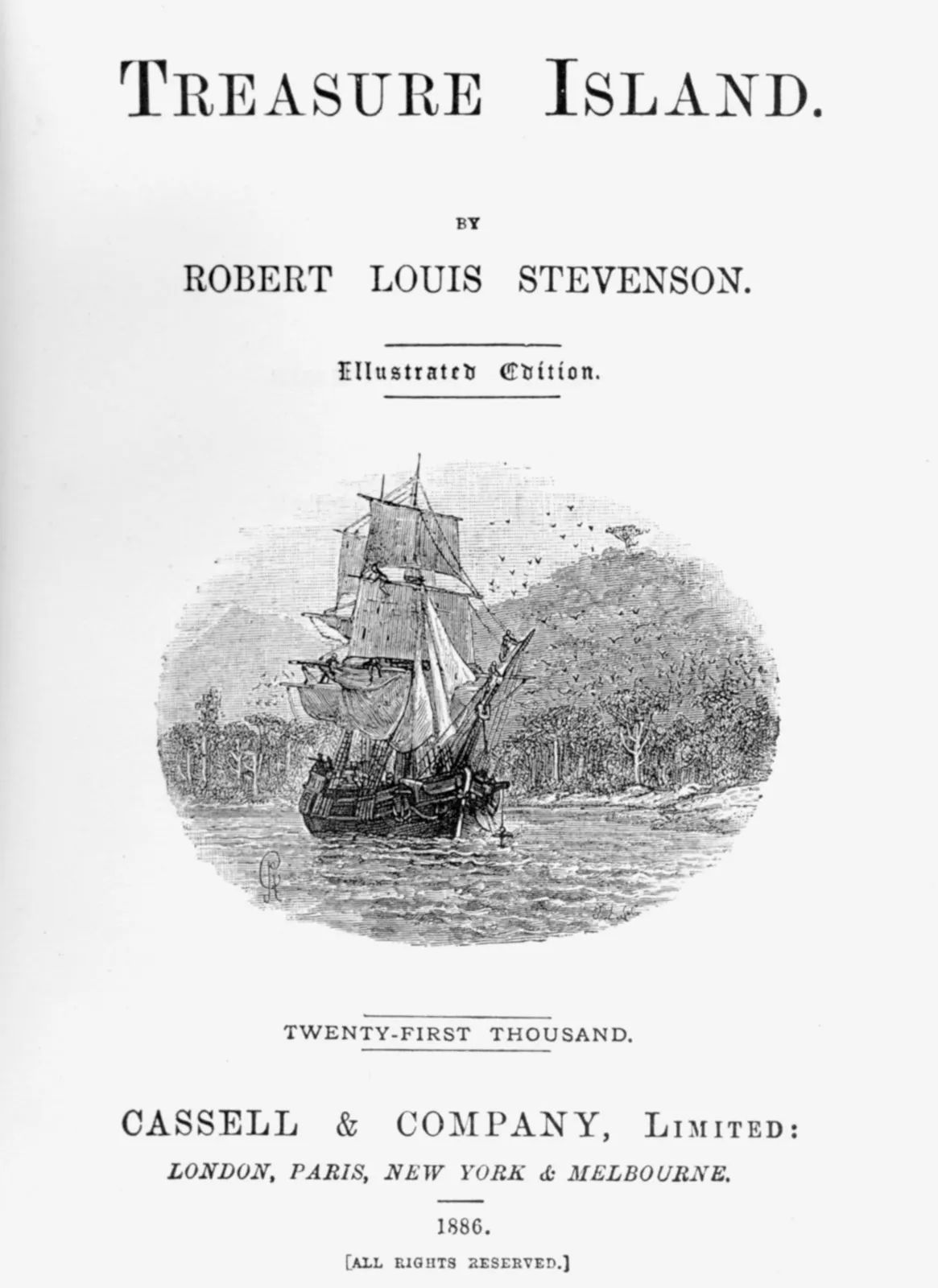
HISTORICAL ALLUSIONS
Real pirates and piracy
Historian Luis Junco suggests that Treasure Island is a combination of the story of the murder of Captain George Glas on board the Earl of Sandwich in 1765 and the taking of the ship Walrus off the island of La Graciosa near Tenerife. The pirates of La Graciosa buried their treasure there, and were subsequently all killed in a bloody battle with the British navy; the treasure was never recovered.
In his book Pirates of the Carraigin, David Kelly deals with the piracy and murder of Captain Glas and others on board a ship travelling from Tenerife to London by the Ship's Cook and his gang. The perpetrators of this crime also buried the considerable treasure they had stolen but most of it was later recovered. They were all executed in Dublin in 1766. In his research, Kelly showed that Stevenson was a neighbour of the named victim in Edinburgh, and so was aware from an early age of these events, which had been a scandal at the time. Stevenson and his family were members of a church congregation set up by the victim's father. Although he never visited Ireland, Stevenson based at least two other books, Kidnapped and Catriona on real crimes that were perpetrated in Dublin; these crimes were all reported in detail in The Gentleman's Magazine, published in Dublin and Edinburgh.
Other allusions to real piracy include:
- Five real-life pirates mentioned are William Kidd (active 1696–1699), Blackbeard (1716–1718), Edward England (1717–1720), Howell Davis (1718–1719), and Bartholomew Roberts (1718–1722). Kidd buried treasure on Gardiners Island, though the booty was recovered by authorities soon afterwards.
- The name "Israel Hands" was taken from that of a real pirate in Blackbeard's crew, whom Blackbeard maimed (by shooting him in the knee) simply to ensure that his crew remained in terror of him. Allegedly, Hands was taken ashore to be treated for his injury and was not at Blackbeard's last fight (the incident is depicted in Tim Powers' novel On Stranger Tides), and this alone saved him from the gallows. Supposedly, he later became a beggar in England.
- Silver refers to "three hundred and fifty thousand" pieces of eight at the "fishing up of the wrecked plate ships". This remark conflates two related events: first, the salvage of treasure from the 1715 Treasure Fleet which was wrecked off the coast of Florida in a hurricane; second, the seizure of 350,000 salvaged pieces of eight the following year (out of several million) by privateer Henry Jennings. This event is mentioned in the introduction to Johnson's General History of the Pyrates.
- Silver refers to a ship's surgeon from Roberts' crew who amputated his leg and was later hanged at Cape Coast Castle, a British fortification on the Gold Coast of Africa. The records of the trial of Roberts' men list Peter Scudamore as the chief surgeon of Roberts' ship Royal Fortune. Scudamore was found guilty of willingly serving with Roberts' pirates and various related criminal acts, as well as attempting to lead a rebellion to escape once he had been apprehended. He was, as Silver relates, hanged, in 1722.
- Stevenson refers to the Viceroy of the Indies, a ship sailing from Goa, India (then a Portuguese colony), which was taken by Edward England off Malabar while John Silver was serving aboard England's ship the Cassandra. No such exploit of England's is known, nor any ship by the name of the Viceroy of the Indies. However, in April 1721, the captain of the Cassandra, John Taylor (originally England's second in command who had marooned him for being insufficiently ruthless), together with his pirate partner, Olivier Levasseur, captured the vessel Nostra Senhora do Cabo near Réunion island in the Indian Ocean. The Portuguese galleon was returning from Goa to Lisbon with the Conde da Ericeira, the recently retired Viceroy of Portuguese India, aboard. The viceroy had much of his treasure with him, making this capture one of the richest pirate hauls ever. This is possibly the event that Stevenson referred to, though his (or Silver's) memory of the event seems to be slightly confused. The Cassandra was last heard of in 1723 at Portobelo, Panama, a place that also briefly figures in Treasure Island as "Portobello".
- The preceding two references are inconsistent, as the Cassandra (and presumably Silver) was in the Indian Ocean during the time that Scudamore was surgeon on board the Royal Fortune, in the Gulf of Guinea.
- A real life 1800s smuggling gang, the "Benbow Brandy Men", operated out of the Benbow pub in Penzance, smuggling gin, brandy, and tobacco to avoid paying the massive import taxes imposed by the Crown to fund its foreign wars.
OTHER ALLUSIONS
- 1689: A pirate whistles "Lillibullero".
- 1702: The Admiral Benbow Inn on the Devon coast, where Jim and his mother live, is named after the real life Admiral John Benbow (1653–1702).
- 1733: Foundation of Savannah, Georgia, where Captain Flint died in 1754.
- 1745: Doctor Livesey was at the Battle of Fontenoy (1745).
- 1747: Squire Trelawney and Long John Silver both mention "Admiral Hawke", i.e. Edward Hawke, 1st Baron Hawke (1705–81), promoted to rear admiral in 1747.
- 1749: The novel refers to the Bow Street Runners (1749).
- Treasure Island was in part inspired by R. M. Ballantyne's The Coral Island, which Stevenson admired for its "better qualities." Stevenson alludes to Ballantyne in the epigraph at the beginning of Treasure Island, "To the Hesitating Purchaser", "...If studious youth no longer crave, His ancient appetites forgot, Kingston, or Ballantyne the brave, Or Cooper of the wood and wave..."
POSSIBLE ALLUSIONS
Characters
- Squire Trelawney may have been named for Edward Trelawney, Governor of Jamaica 1738–52.
- Dr. Livesey may have been named for Joseph Livesey (1794–1884), a famous 19th-century temperance advocate, founder of the tee-total "Preston Pledge". In the novel, Dr. Livesey warns the drunkard Billy Bones that "the name of rum for you is death."
Treasure Island
Various claims have been made that one island or another inspired Treasure Island:
- Isla de Pinos near Cuba, which served as a supply base for pirates for about 300 years, is believed to have inspired Treasure Island.
- Norman Island in the British Virgin Islands was supposedly mentioned to Stevenson by a sailor uncle, and also possesses a "Spyglass Hill" like the fictional Treasure Island.
- Cocos Island off Costa Rica has many similarities with the fictional treasure island. British trader Captain William Thompson buried the stolen treasury of Peru there in 1820; an original inventory showed 113 gold religious statues (one a life-sized Virgin Mary), 200 chests of jewels, 273 swords with jeweled hilts, 1,000 diamonds,
solid-gold
crowns, 150 chalices, and hundreds of gold and silver bars. The real treasure has never been found, despite more than 300 expeditions to the island. Stevenson mentions the buried treasure and Captain Thompson in an 1881 letter to W. E. Henley, where he also provides the earliest known title for the book: "The Sea Cook, or Treasure Island: a Story for Boys".
- Dead Chest Island, a barren rock in the British Virgin Islands, which Stevenson found mentioned in Charles Kingsley's At Last: A Christmas in the West Indies, and which he said "was the seed" for the phrase "Dead Man's Chest".
- Small pond in Queen Street Gardens in Edinburgh, said to have been visible from Stevenson's bedroom window in Heriot Row.
- The Napa Valley, California, where Stevenson spent his honeymoon in 1880, as narrated in his The Silverado Squatters (1883).
- Osborn Island (now Nienstedt Island) in the Manasquan River in Brielle, New Jersey. Stevenson supposedly visited there in May 1888 (five years after writing Treasure Island) and christened it "Treasure Island"
- Fidra in the Firth of Forth, visible from North Berwick where Stevenson had spent many childhood holidays.
- Unst, one of the Shetland Islands, to which the map of Treasure Island bears a very vague resemblance.
- R. F. Delderfield, in The Adventures of Ben Gunn, suggests that its real name is Kidd's Island, and identifies it as an outlying island of the Leeward Islands and Windward Islands, south-south-west of Tobago (pp. 119–120).
CLAIMED LINK TO THE TOWNS OF BIRKENHEAD AND WALLASEY NEAR LIVERPOOL
In August 2022 the British Member of Parliament for Birkenhead, Mick Whitley, supported the findings of local historian John Lamb, that Robert Louis Stevenson had set his classic novel Treasure Island in the towns of Birkenhead and Wallasey on the Wirral Peninsula lying opposite Liverpool. This followed a previous announcement by Alan Evans of Wirral Borough Council that the French science fiction writer Jules Verne had also set his 1874 novel The Mysterious Island in Birkenhead. Their Letters of support for Mr Lamb's claims were posted on the Jules Verne and the Heroes of Birkenhead website in August 2022.
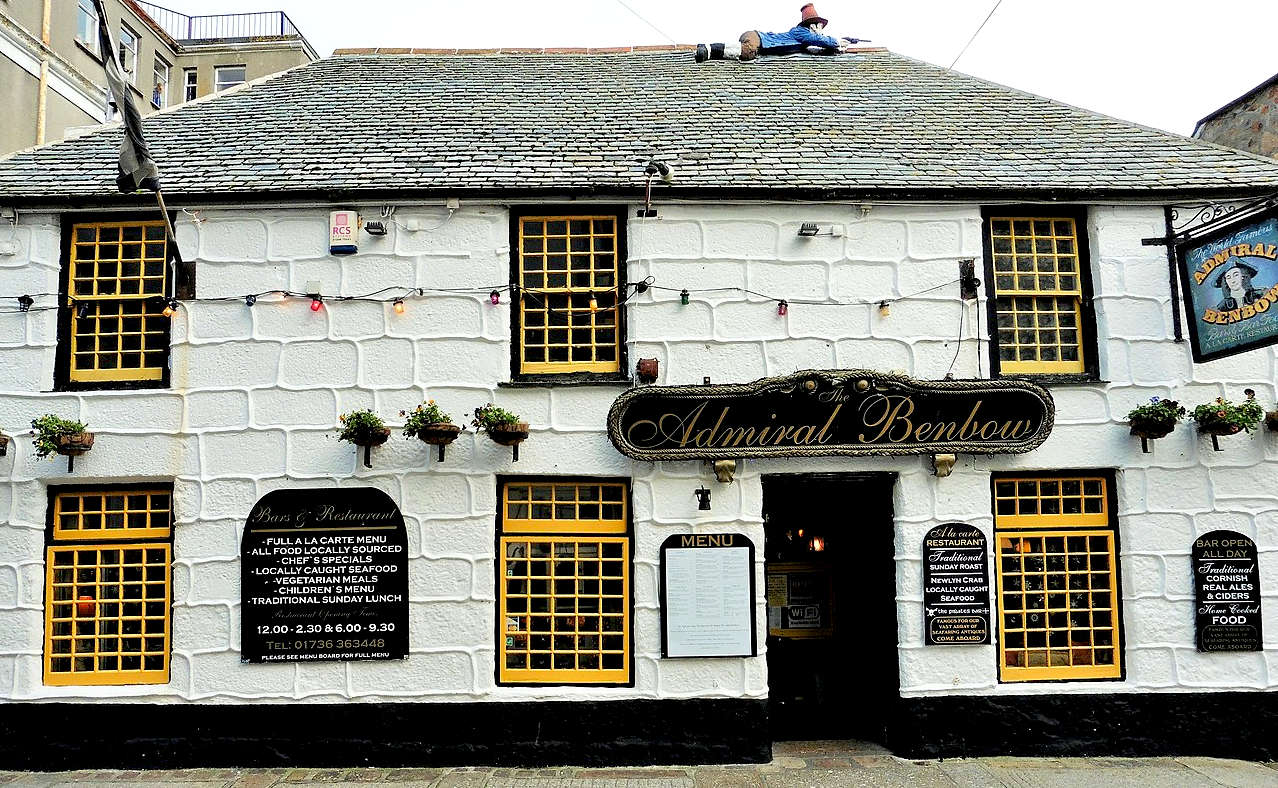
OTHER PLACES
The Admiral Benbow in Penzance, reportedly an inspiration for Stevenson's Inn
Both the Llandoger Trow in Bristol, and the Admiral Benbow in Penzance, have claimed to be an inspiration for the Admiral Benbow Inn. Stevenson visited Cornwall and Penzance in August 1877, and as inn is described in the book as being in a rural area and it was necessary to travel to Bristol, Penzance's "Benbow Brandy Men" may have inspired him to feature the Penzance Benbow in Treasure Island.
The Hole in the Wall, in Bristol, is claimed to be the Spyglass Tavern.
The Pirate's House in Savannah, Georgia, is where Captain Flint is claimed to have spent his last days, and his ghost is claimed to haunt the property.
SEQUELS, PREQUELS AND WORDBUILDING
Stevenson's Treasure Island spawned an enormous amount of literature based one way or another upon his original novel:
Porto Bello Gold (1924), a prequel by A. D. Howden Smith that was written with explicit permission from Stevenson's executor, tells the origin of the buried treasure and recasts many of Stevenson's pirates in their younger years, giving the hidden treasure some Jacobite antecedents not mentioned in the original.
Back to Treasure Island (1935) is a sequel by H. A. Calahan, the introduction of which argues that Robert Louis Stevenson wanted to write a continuation of the story.
The Adventures of Ben Gunn (1956), by R. F. Delderfield, follows Ben Gunn from parson's son to pirate and is narrated by Jim Hawkins in Gunn's words.
Flint's Island (1972), a sequel by Leonard Wibberley, who notes in the introduction that it had long been a dream of his to do so.
Long John Silver - Den äventyrliga och sannfärdiga berättelsen om mitt liv och leverne som lyckoriddare och mänsklighetens fiende (1998) is a prequel by the Swedish author Björn Larsson, who tells the fictional story of the pirate Long John Silver, told in first person by Silver himself in a manuscript in his last days of life.
Jim Hawkins and the Curse of Treasure Island (2001) is a sequel by Frank Delaney under the pseudonym "Francis Bryan".
Before (2001) is a prequel by Michael Kernan, published in the Netherlands as Vóór Schateiland.
Sept Pirates (2007) is a comic-book sequel by Pascal Bertho and artist Tom McBurnie.
Long John Silver (2007) is a four-volume French graphic novel by Xavier Dorison and artist Mathieu Lauffray.
Flint & Silver (2008) is a prequel by John Drake, who followed with two additional books: Pieces of Eight (2009) and Skull and Bones (2010).
Return to Treasure Island (2010) is a sequel by John O'Melveny Woodswrote.
Treasure Island: The Untold Story (2011) is a true-life prequel by John Amrhein, Jr.
Silver: Return to Treasure Island (2012) is a sequel by former Poet Laureate of the United Kingdom Andrew Motion.
Treasure Island!!! (2012) is a novel by Sara Levine about an American woman who becomes obsessed with Treasure Island (Europa Editions, 2012).
Tread Carefully on the Sea (2014), by David K. Bryant, merges all the references to Captain Flint into a prequel covering the burial of the treasure.
Skulduggery (1991/2014), a prequel written by Tony Robinson which features Ben Gunn attending a school for pirates and meeting junior counterparts of Blind Pew and Long John Silver. Originally published as part of the Silvery Jackanory compilation in 1991. (ISBN 9781781124086)
FILM AND TELEVISION
A number of sequels have also been produced in film and television, including:
- Return to Treasure Island (1954), a film by E. A. Dupont
- Return To Treasure Island (1986), written by Ivor Dean, Robert S. Baker, and John Goldsmith, is a HTV television series that features Silver, Hawkins, and Gunn.
- A 1992 animation version and a 1996 and 1998 TV version
- Black Sails (2014–2017), a prequel drama series by Robert Levine and Jonathan E. Steinberg, tells the story of Captain Flint and John Silver leading up to the Treasure Island story. The series is said to take place 20 years before the events of the book, in 1715; however this is actually 40 years before the dates given by Stevenson. The series consists of four seasons.
WORDBUILDING
In worldbuilding, there are:
- Admiral Guinea (publ. 1892), a play written by R. L. Stevenson with W. E. Henley, features the blind ex-pirate Pew as a character under the name of "David Pew".
- In his collection Fables (1896), Stevenson wrote a vignette called "The Persons of the Tale", in which puppets Captain Smollet and Long John Silver discuss
authorship.
- In the novel Peter and Wendy (1911) by J. M. Barrie, it is said that Captain Hook is the only man ever feared by the Old Sea Cook (i.e., Long John Silver); Captain Flint and the Walrus are also referenced, among others.
- In the film The Pagemaster (1994), the hero is confronted by Long John Silver, who surrenders and leaves after he is threatened with a sword
- In the animated series Fox's Peter Pan and the Pirates (based, in part, on the original Peter Pan stories), Captain Flint is referenced in the episode "Peter on Trial", as Captain Hook is stated as being the only man that a pirate named Barbecue is stated to fear, with the following statement being that, "even Flint feared Barbecue," referring to Captain Flint from Treasure Island. Barbecue is the crew's nickname for Long John Silver in the novel. In the same episode, Flint is referenced as being the pirate who supposedly conceived of the idea of pirates putting members of their crew or their prisoners as the case might be, on trial in an event called 'Captain's Mast'.
- Treasure Island made an appearance in Doraemon the Movie: Nobita's Treasure Island, the 2018 entry of the popular Doraemon movie series which is also a loose adaptation of the book.
ADAPTATIONS: FILMS ENGLISH LANGUAGE
- Treasure Island (1918) — a silent film released by Fox Film Corporation and directed by Sidney Franklin and Chester Franklin.
- Treasure Island (1920) — a silent film notably starring a woman, Shirley Mason, as Jim Hawkins, along with Charles Ogle, who had played Frankenstein's monster a decade earlier in the Edison version of Frankenstein, as Long John Silver. Said to be a lost film, it was directed by Maurice Tourneur and released by Paramount Pictures.
- Treasure Island (1934) — the first sound film version remains a lavish and energetic thriller starring Wallace Beery, Jackie Cooper and Lionel Barrymore.
- Treasure Island (1950) — starring Bobby Driscoll and Robert Newton, notable for being the first version in colour and the Walt Disney Studios' first completely live-action film. A sequel to this version was made (but not by Disney) in 1954, entitled Long John Silver, which also starred Newton in the titular role.
- Treasure Island (1972) — starring Orson Welles, was produced by National General Pictures, and directed by John Hough, Andrew White, and John Salway.
- Treasure Island (1973) - a Warner Bros. Family Entertainment animated film directed by Hal Sutherland, written by Ben Starr, starring Richard Dawson as Long John Silver, Davy Jones as Jim Hawkins, and Dal McKennon as Captain Flint & Ben Gunn.
- Treasure Island (1990) - a TNT film directed by Fraser Heston, starring Charlton Heston as Long John Silver, and a young Christian Bale as Jim Hawkins.
- Muppet Treasure Island (1996) — a film produced by The Jim Henson Company and released by Walt Disney Pictures, starring the Muppets. The human performers include Tim Curry as Long John Silver, Billy Connolly as Billy Bones, Jennifer Saunders as Mrs. Bluberidge, and newcomer Kevin Bishop as Jim Hawkins.
- Treasure Island (1999) — starring Jack Palance as Long John Silver, Patrick Bergin as Billy Bones, Christopher Benjamin as Squire Trelawney and Kevin Zegers as Jim Hawkins.
- Treasure Planet (2002) — a reimagined adaptation from Walt Disney Animation Studios set in space, with Long John Silver as a cyborg and many of the original characters re-imagined as aliens and robots, except for Jim, his mother and his father, who are human.
ADAPTATIONS: FOREIGN LANGUAGE FILMS
- Treasure Island (1937) — a loose Soviet adaptation starring Osip Abdulov and Nikolai Cherkasov, with a score by Nikita Bogoslovsky.
- Between God, the Devil and a Winchester (1968), a spaghetti western version starring Richard Harrison and Gilbert Roland.
- Treasure Island (1971) — a Soviet (Lithuanian) film starring Boris Andreyev as Long John Silver, with a score by Alexei Rybnikov.
- Animal Treasure Island (1971) — an anime film directed by Hiroshi Ikeda, written by Takeshi Iijima and Hiroshi Ikeda, with story consultation by famous animator Hayao Miyazaki. This version replaces several of the human characters with animal counterparts.
- The Treasure Planet (Planetata na sakrovishtata; 1982), a Bulgarian animated science fiction adaptation directed by Rumen Petkov.
- Treasure Island (1982) — a Soviet film in three parts; almost entirely faithful to the text of the novel. Featuring Oleg Borisov as Long John Silver.
- L'Île au trésor (1985) — a Chilean-French adaptation starring Vic Tayback as Long John Silver.
- Il Pianeta Del Tesoro – Treasure Planet (1987; aka Treasure Island in Outer Space) — Italian/German science-fiction adaptation starring Anthony Quinn as Long John Silver.
- Treasure Island (1988) — a critically acclaimed Soviet animation film in two parts, released in the United States (1992) as Return to Treasure Island.
- L'Île aux trésors (2007) — a French-British-Hungarian film directed by Alain Berbérian, starring Gérard Jugnot, Alice Taglioni, Vincent Rottiers and Jean-Paul Rouve.
TV FILMS
- Treasure Island (1990) — a made-for-TV film, starring Charlton Heston, Christian Bale, Oliver Reed, Christopher Lee and Pete Postlethwaite; written, produced and directed by Heston's son, Fraser C. Heston.
- Treasure Island Pirate (1991)
- Treasure Island (1995) — a made-for-TV movie directed by Ken Russell and starring Hetty Baynes as Long Jane Silver.
- Pirates of Treasure Island (2006) — a direct-to-DVD film by The Asylum.
TELEVISION
Treasure Island (1951) — a seven-part BBC series starring Bernard Miles as Long John Silver.
The Adventures of Long John Silver (1955) — 26 episodes shot at Pagewood Studios, Sydney, Australia filmed in full colour and starring Robert Newton.
"Mr. Magoo's Treasure Island" (1964) — a two-part episode of the cartoon series The Famous Adventures of Mr. Magoo, was based on the novel, with Mr. Magoo in the role of Long John Silver.
Treasure Island (1966) — a German-French co-production for German television station ZDF.
Treasure Island (1968) — a BBC series of nine 25-minute episodes starring Peter Vaughan.
Treasure Island (1977) — a BBC adaptation Starring Ashley Knight and Alfred Burke.
Treasure Island (Takarajima; 1978) — a Japanese animated series adapted from the novel.
"Treasure Island" (1988) — an episode of Alvin and the Chipmunks starring Alvin as Jim Hawkins, Dave as Long John Silver, Simon as Dr. Livesey, Theodore as Squire Trelawney, and Brittany as Mrs. Hawkins.
The Legends of Treasure Island (1993–1995) — an animated series loosely based on the novel, with the characters as animals.
"Salty Dog" — an episode of Wishbone in which the eponymous character explores the story in a children's adapted version.
Treasure Island: The Adventure Begins (1994) — a TV movie special promoting the Treasure Island Hotel and Casino.
Treasure Island (2012) — two-part serial starring Eddie Izzard, shown on Sky1 (United Kingdom) from 1–2 January.
Treasure Island (L'isola del tesoro; 2015) — an Italian CGI animated series by Rai Fiction and Mondo TV. It mixes the original work with new characters and mythical elements such as voodoo.
THEATRE
There have been over 24 major stage adaptations made, though the number of minor adaptations remains countless. The story is also a popular plot and setting for a traditional pantomime wherein Mrs. Hawkins, Jim's mother is the dame.
In 1947, a production was mounted at the St. James's Theatre in London, starring Harry Welchman as Long John Silver and John Clark as Jim Hawkins.
For a time, in London, there was an annual production of the musical Treasure Island, based on a book by Bernard Miles and Josephine Wilson. The music was composed by Cyril Ornadel and the lyrics by Hal Shaper. The musical was performed at the Mermaid Theatre, originally under the direction of Bernard Miles, who played Long John Silver, a part he also played in a television version. Comedian Spike Milligan would often play Ben Gunn in these productions, and in 1981, Tom Baker played Long John Silver.
Pieces of Eight (1985), premiered in Edmonton, Alberta, is a musical adaptation by Jule Styne.
In 1986, a Danish language musical adaptation of Treasure Island named Skatteøen premiered at Folketeatret, Copenhagen, written by singer-songwriter Sebastian. Since its premiere, it has been put to stage frequently by several Danish theatre companies.
In 2007, an adaptation of Treasure Island by Ken Ludwig premiered at the Alley Theatre, Houston; played at the Theatre Royal, Haymarket on London's West End in 2008; and won the AATE Distinguished Play Award for Best Adaptation of the Year.
An adaptation in August 2009 was run by the Henegar Center for the Arts in downtown historic Melbourne, Florida.
Treasure Island: the Curse of the Pearl Necklace (2014–15), by Jon Bradfield and Martin Hooper, is an alternative pantomime that included gay, lesbian, and trans characters, and played a sold-out run at London's Above The Stag Theatre.
In 2011, Tom Hewitt starred in B.H. Barry and Vernon Morris's stage adaptation of the novel, which officially opened 5 March at the Irondale Center in Brooklyn.
In July 2011, Bristol Old Vic staged a large-scale outdoor production of Treasure Island outside the theatre on King Street, Bristol directed by Sally Cookson, with music by Benji Bower.
From October 2013 to 2014, Mind the Gap Theatre Company, a leading UK theatre company in working with actors with learning disabilities, embarked on a national tour of Treasure Island, retold with a twist by Olivier award-winning writer Mike Kenny.
In 2013, YouthPlays published Long Joan Silver by Arthur M. Jolly, an adaptation in which all of the pirates are women.
A version by Bryony Lavery and directed by Polly Findlay was produced at London's Royal National Theatre from December 2014 to April 2015. In this version of the play, Jim is a girl. This production starred rising actor Patsy Ferran as Jim and Doctor Who alumnus Arthur Darvill as Silver.
As part of their 2017 Season, the Stratford Festival of Canada premiered an adaptation of Treasure Island by Canadian playwright Nicolas Billon.
In 2018 the newly reopened Leicester Haymarket Theatre staged a new version of Treasure Island, adapted by Sandi Toksvig, as their first Christmas show in 10 years.
AUDIO RADIO
Orson Welles broadcast a radio adaptation via The Mercury Theatre on the Air in July 1938, with its setting being half in England and half on the Island. The broadcast, which omits "My Sea Adventure", included music by Bernard Herrmann.
William Redfield played Silver on the May 14, 1948 Your Playhouse of Favorites adaptation.
Ronald Colman hosted an adaptation of the novel on the April 27, 1948, broadcast of Favorite Story.
James Mason played Silver opposite Bobby Driscoll's "Jim Hawkins" on the Lux Radio Theatre's adaptation on January 29, 1951.
There have been two BBC Radio adaptations of Treasure Island, with Silver being played by Peter Jeffrey in 1989, and Jack Shepherd in 1995.
Author John le Carré performed an abridged reading of the novel in five parts as part of BBC Radio 4's Afternoon Reading.
Treasure Island 2020 (November 12, 2018 - January 12, 2020) is a 10-part BYU Radio radio adaptation broadcast via The Apple Seed. The audio adventure places the main trio of kids in 2019 and turns it into a time-traveling adventure that involves both them going to the past to look for treasures and Long John Silver, Billy Bones, and others coming to the present through the time vortex. The series is now available as a free podcast.
OTHER AUDIO RECORDINGS
Basil Rathbone starred as both The Narrator and Silver in a 1944 audio recording for Columbia Masterworks Records.
James Kenney played Jim Hawkins and Anthony Woodruff played Long John Silver in the Tale Spinners for Children audio adaptation of Treasure Island (United Artists Records, UAC 11013).
A 2013 Big Finish Productions audiobook adaptation of Treasure Island was written and directed by Barnaby Edwards and starred Tom Baker as Long John Silver, Nicholas Farrell as the Narrator, and Edward Holtom as Jim Hawkins.
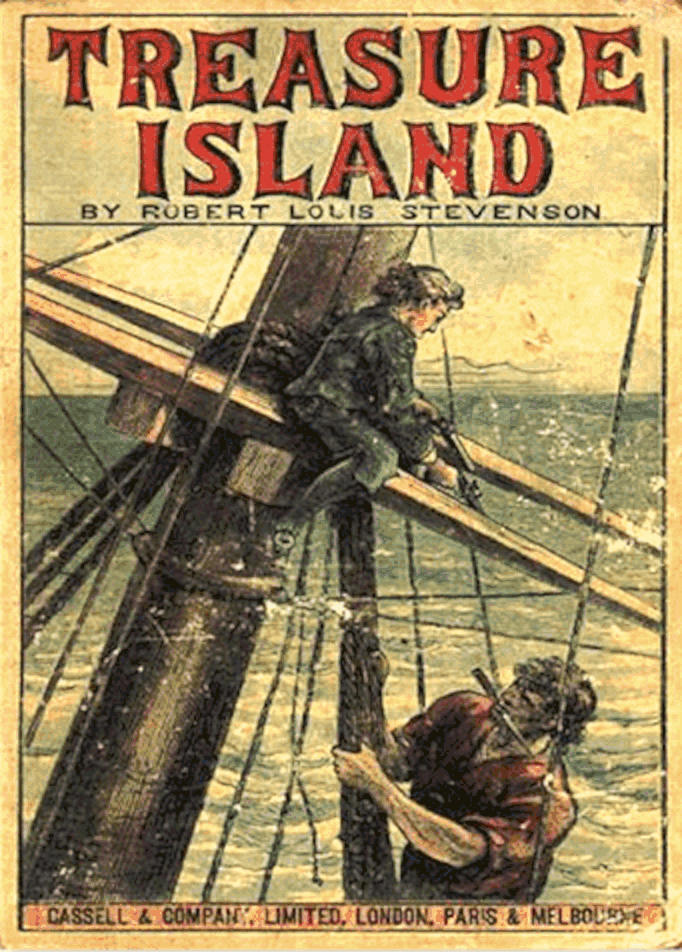
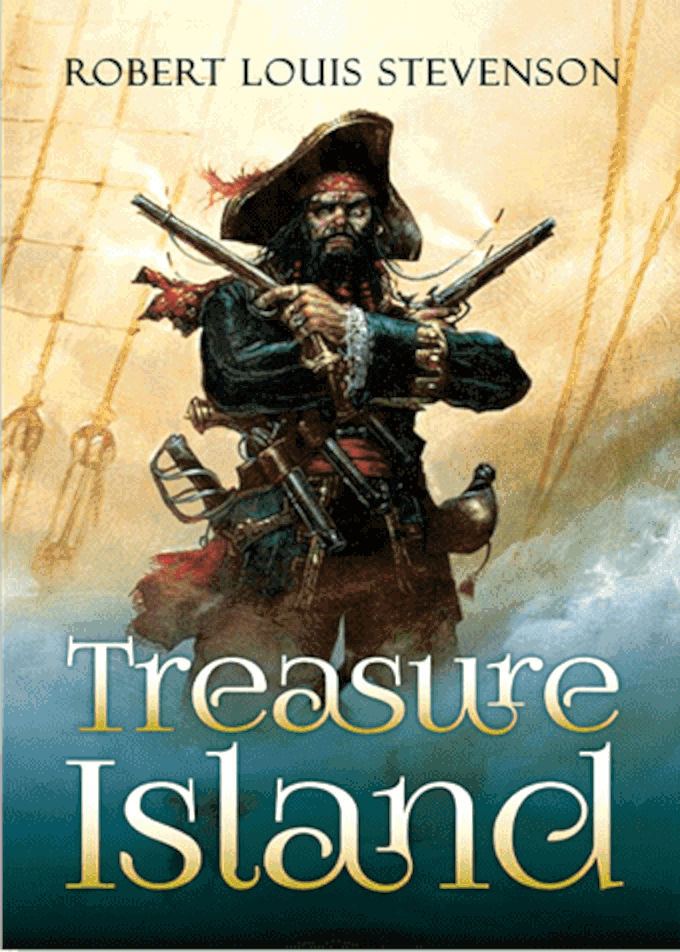
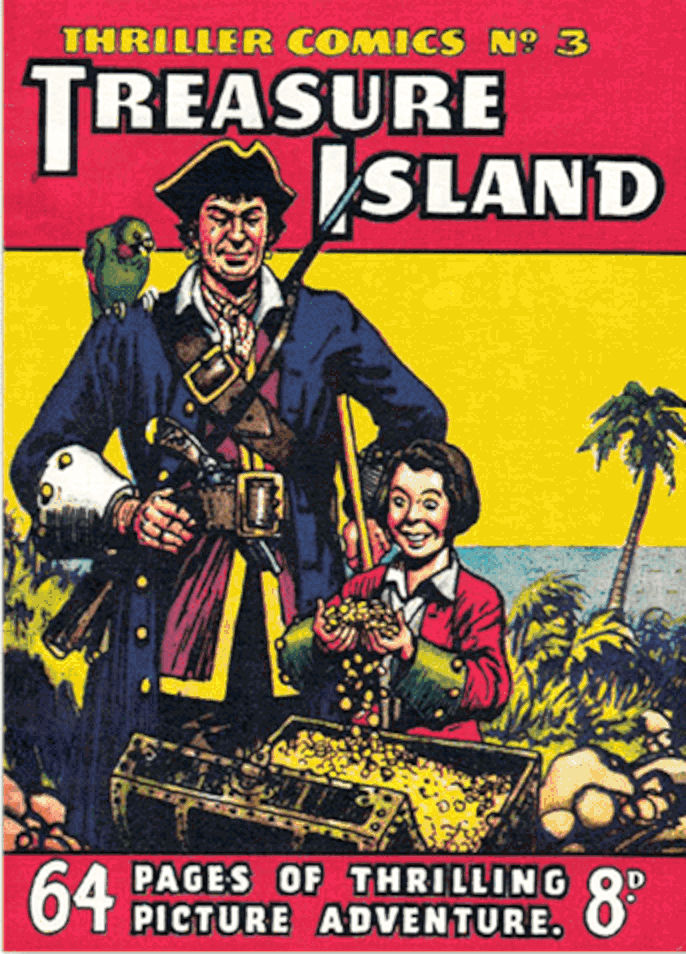
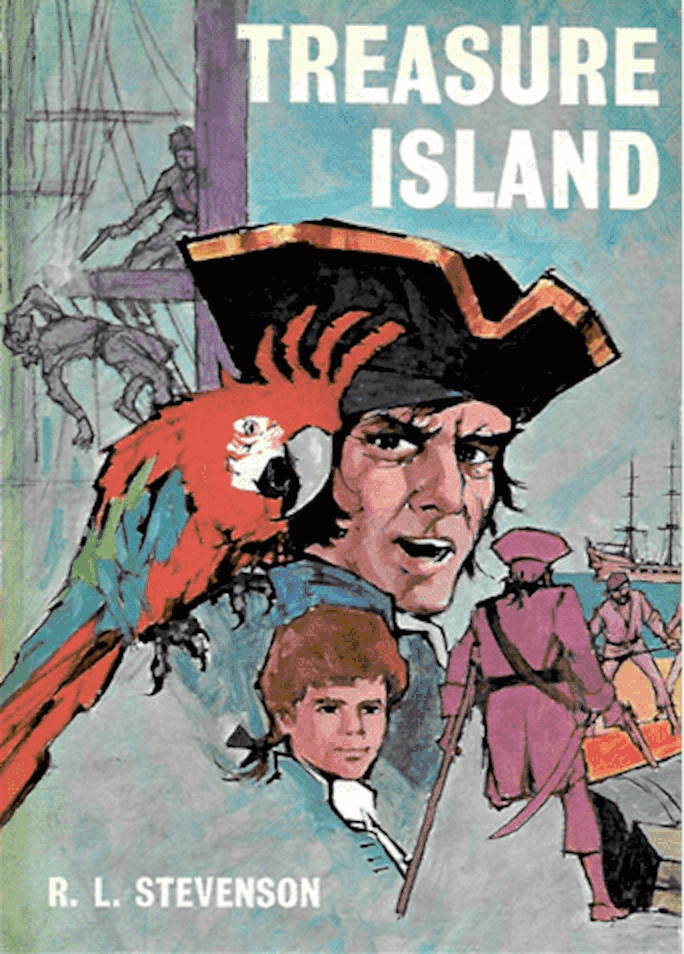
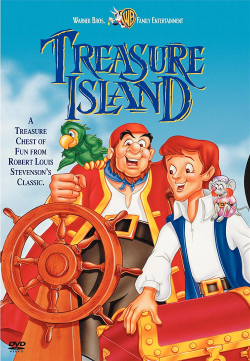
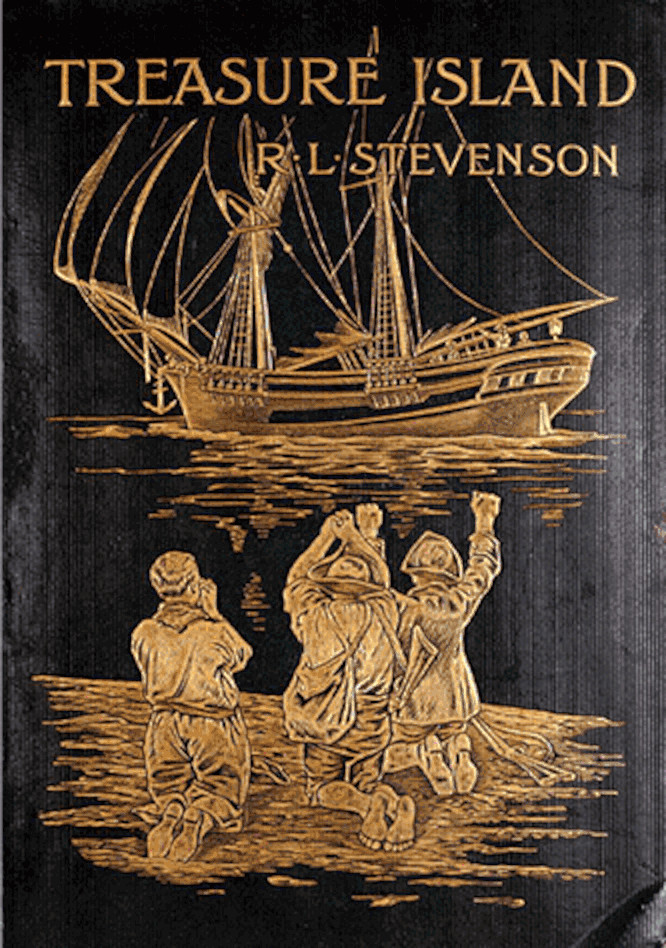
BOOKS AND COMICS
Famous Stories #1 (1942, Dell Comics) — sixty pages, drawn by Robert Bugg
Shin Takarajima (1947) — a loose adaptation of Treasure Island by Sakai Shichima and Osamu Tezuka
Classics Illustrated #64 (Oct. 1949, Gilberton) — adapted by Ken Fitch and Alex A. Blum
"Walt Disney's Treasure Island", Four Color #624 (April 1955, Dell Comics) — adapted by John Ushler from Disney's 1950 film adaptation
"La isla del tesoro", Joyas Literarias Juveniles #2 (1970, Editorial Bruguera) — adapted by José Antonio Vidal Sales and Alfonso Cerón Nuñez; translated and reprinted as "Treasure Island", King Classics #7 (1977, King Features)
Pendulum Illustrated Classics (1973, Pendulum Press) — adapted by John Norwood Fago and Nardo Cruz
Marvel Classics Comics #15 (1976, Marvel Comics) — adapted by Bill Mantlo and Dino Castrillo; re-issued by Fisher-Price in 1984
Godspeed (1993) — a science-fictional novel by Charles Sheffield that recasts the search for pirate treasure as the search for lost faster-than-light drive technology
Robert Louis Stevenson's Treasure Island: The Graphic Novel (2005, Penguin Books) — adapted by Tim Hamilton
Robert Louis Stevenson's Treasure Island (2007, Capstone Publishers) — adapted by Greg Rebis
Treasure Island #1–6, Marvel Illustrated (Aug. 2007–Jan. 2008, Marvel Comics) — adapted by Roy Thomas, Mario Gully, and Pat Davidson
L'Île au trésor, de Robert Louis Stevenson (2007–2009, Delcourt) — adapted by David Chauvel and Fred Simon; translated and reprinted as Papercutz Classics Illustrated Series #5 (2010, Papercutz)
Disney Treasure Island, Starring Mickey Mouse (Oct. 2018, Dark Horse Comics) — adapted by Teresa Radice, Erin Brady (translation), and Stefano Turconi
MUSIC
The self-titled Ben Gunn Society album released in 2003 presents the story centred on the character of Ben Gunn, based primarily on Chapter XV, "Man of the Island", and other relevant parts of the book.
"Treasure Island" (1992) is a song by Running Wild, from their Pile of Skulls album, that tells the novel's story.
Scottish glam rock artists The Sensational Alex Harvey Band paid tribute to the book with their 1974 song "The Tomahawk Kid." The song names many of Treasure Island's characters in its lyrics, and was often dedicated to Robert Louis Stevenson in live performance.
"I'm Still Here (Jim's Theme)" and "Always Know Where You Are" are songs performed by Goo Goo Dolls frontman John Rzeznik for Disney's animated retelling.
The Cursed Island (2014) is an album by Skull & Bones that is based on Treasure Island.
VIDEO GAMES
A graphical adventure computer game based loosely on the novel was written by Greg Duddle, published by Mr. Micro (and often rebranded by Commodore) on the Commodore 16, Commodore Plus/4, Commodore 64, and ZX Spectrum. In the game, the player takes the part of Jim Hawkins travelling around the island dispatching pirates with cutlasses before getting the treasure and being chased back to the ship by Long John Silver.
Treasure Island (1985) is an adventure game based upon the novel published by Windham Classics.
La Isla del Tesoro de R. L. Stevenson (1999) is a point-and-click adventure game based upon the novel developed, edited, and published by Barcelona Multimedia.
Monkey Island, a LucasArts adventure game, is partly based on Treasure Island, lending many of its plot points and characters and using many humorous references to the book.
Treasure Planet: Battle at Procyon is one of the various video games released by Disney based on their animated film Treasure Planet.
Treasure Island (2010) is a hidden objects game launched by French publisher Anuman Interactive.
Captain Silver is an arcade game that follows its protagonist, Jim Aykroyd, in his quest to find Captain Silver's hidden treasure, for which he must battle an undead Captain Silver in order to find.
REFERENCES IN POPULAR CULTURE
* The Strong Winds series of children's adventures by Julia Jones draws freely from events and names in Treasure Island.
* In the Swallows and Amazons series by Arthur Ransome, the Blacketts' Uncle Jim has the nickname of Captain Flint and a parrot.
* A 1960 episode of Dennis the Menace is centered around the pursuit of buried treasure, inspired by Mr. Wilson reading his childhood copy of Treasure Island to Dennis and his friends.
* In 1988, The Soviet Director David Cherkassky released the 1988 Soviet film Treasure Island which relates to the book
* Treasure Island According to Spike Milligan (2000) is a parody by Spike Milligan
*
At the beginning of a fifth-season episode of Arthur titled "You Are Arthur" (2000), the titular character is seen reading Treasure Island.
* In an episode of Survivor: Heroes vs Villains, titled "Jumping Ship" (2010), the castaways Amanda, Colby and Danielle win an overnight trip to the former home of Robert Louis Stevenson and a screening of the 1934 version of Treasure Island.
* In The Way Back (2010), one of the prisoners in the Russian gulag briefly narrates some of Treasure Island to his fellow inmates. He mentions the characters Jim and Long John Silver.
* In the teen fiction novel One for Sorrow (2015, Fledgling Press) by Philip Caveney, the main character, Tom Afflick, is reading Treasure Island which serves as the catalyst for his adventure.
* In Blade Runner 2049 (2017), Rick Deckard makes a continued allusion to Treasure Island upon first meeting the protagonist; in the scene, he explicitly references Ben Gunn's craving for cheese.
"It reads."
* In the finale of Season 3 of The Handmaid's Tale (2019), Commander Lawrence reads an excerpt of Treasure Island to a group of runaway children.
SOURCES
Barker-Benfield, Simon (2014). The Annotated Treasure Island. ISBN 978-1-937075-01-9
Cordingly, David (1995). Under the Black Flag: The Romance and Reality of Life Among the Pirates. ISBN 0-679-42560-8.
Letley, Emma, ed. (1998). Treasure Island (Oxford World's Classics). ISBN 0-19-283380-4.
Pietsch, Roland (2010). The Real Jim Hawkins: Ships' Boys in the Georgian Navy. ISBN 978-1-84832-036-9.
Reed, Thomas L. (2006). The Transforming Draught: Jekyll and Hyde, Robert Louis Stevenson, and the Victorian Alcohol Debate. ISBN 0-7864-2648-9.
Watson, Harold (1969). Coasts of Treasure Island: A Study of the Backgrounds and Sources for Robert Louis Stevenson's Romance of the Sea. ISBN 0-8111-0282-3.
REFERENCES
Hammond, J. R. 1984. "Treasure Island." In A Robert Louis Stevenson Companion, Palgrave Macmillan Literary Companions. London: Palgrave Macmillan. doi:10.1007/978-1-349-06080-1_6.
Cordingly, David (1995) Under the Black Flag: the romance and reality of life among the pirates; p. 7
Bradford A. Booth; Ernest Mehew. The Letters of Robert Louis Stevenson. p. p.iii. 225.
Sergeant, D.R.C. "Capitalism and the Romance in R. L. Stevenson's Treasure Island". University of Plymouth. 29 July 2021.
Louis, Stevenson, Robert (1986). "My First Book – Treasure Island". The Courier.
"Bid to trace lost Robert Louis Stevenson manuscripts". BBC News. 9 July 2010.
Stevenson, Chapter 16: "I was not new to violent death - I have served his Royal Highness the Duke of Cumberland, and got a wound myself at Fontenoy
- but I know my pulse went dot and carry one."
"The murder of Captain Geoge Glas – the original inspiration for Treasure Island?". History Scotland. 20 August 2018. 29 February 2020.
Adams, Cecil The Straight Dope: Did pirates bury their treasure? Did pirates really make maps where "X marks the spot"? Archived 4 May 2016 at the Wayback Machine 5 October 2007
Gainey, Tom (10 December 2017). "Cornwall's smuggling past - a look at six pubs at the heart of a 'golden age' of criminality". The Cornishman.
Brantlinger, Patrick (2009), Victorian Literature and Postcolonial Studies, Edinburgh University Press, ISBN 978-0-7486-3304-3, p. 33
"The Coral
Island", Children's Literature Review, January 2009, 4 May 2012. via HighBeam (subscription required)
Reed, Thomas L. 2006. The Transforming Draught: Jekyll and Hyde, Robert Louis Stevenson, and the Victorian Alcohol Debate mustache. pp. 71–73.
Hothersall, Barbara. "Joseph Livesey". Archived from the original on 22 July 2009. 24 December 2009.
Boobbyer, Claire (29 November 2013). "Cuba's hidden treasure: La Isla de la Juventud".
22 August 2019 – via www.theguardian.com.
"Treasure Island". thecareergamer.com. 22 August 2019.
"Where's Where" (1974) (Eyre Methuen, London) ISBN 0-413-32290-4
"At Last: A Christmas in the West Indies". 1871.
David Cordingly. Under the Black Flag: The Romance and the Reality of Life Among the Pirates. ISBN 0-679-42560-8.
Robert Louis Stevenson. "To Sidney Colvin. Late May 1884", in Selected Letters of Robert Louis Stevenson. p. 263.
"Brilliance of 'World's Child' will come alive at storytelling event" Archived 23 May 2007 at the Wayback Machine, (The Scotsman, 20 October 2005).
Richard Harding Davis (1916). Adventures and Letters of Richard Harding Davis, p. 5. From Project Gutenberg.
"History of Brielle". 14 August 2021.
"Fidra". Gazetteer for Scotland. 18 June 2008.
"Visit Unst | The Shetland Islands". Visit Unst | An Unparalleled Island Adventure.
22 August 2019.
https://julesverneandtheheroesofbirkenhead.co.uk/wp-content/uploads/2022/08/38.-
A-Statement-from-Birkenhead-Member-of-Parliament-Mick-Whitley..pdf
"Teacher makes 'one of the great discoveries of world literature'". 9 August 2022.
https://julesverneandtheheroesofbirkenhead.co.uk/wp-content/uploads/2021/11/6.-
Jules-Verne-Sets-His-Classic-Novel-The-Mysterious-Island-in-Birkenhead.pdf
"Bristol's history". Visit Bristol. 2 June 2011.
Townsend (9 December 2007). "Hole in the Wall Queen Square Bristol". Flickr. 2 June 2011.
"The Pirates House history". Thepirateshouse.com. Archived from the original on 17 May 2011. 2 June 2011.
"Ghost of Captain Flint". CNN. 31 October 2003. Retrieved 2 June 2011.
"Uitgeverij Conserve – Vóór Schateiland". www.conserve.nl.
22 August 2019.
"Results for 'au:Drake, John' [WorldCat.org]". 16 October 2015. Archived from the original on 16 October 2015.
22 August 2019.
Woods, John O'Melveny (22 August 2010). Return to Treasure Island: the lost journals of Sir James Hawkins. Intellect Pub. OCLC 449250770.
Treasure Island: The Untold Story or The Real Treasure Island. New Maritima Press. OCLC 795019447.
Silver: Return to Treasure Island by Andrew Motion Archived 29 April 2016 at the Wayback Machine – review by Ian Sansom in The Guardian, 30 March 2012
Bevis, Matthew (25 October 2012). "Matthew Bevis · Kids Gone Rotten: 'Treasure Island' · LRB 25 October 2012". London Review of Books. 21 September 2021.
"Black Sails". IMDb. Retrieved 28 July 2018.
Stevenson, Robert Louis. Fables Archived 3 March 2016 at the Wayback Machine.
Dury, Richard. Film adaptations of Treasure Island Archived 2 April 2016 at the Wayback Machine.
"SilentEra entry". Silentera.com. 2 June 2011.
Leggett, Steve. 29 December 2016. " List of 7200 Lost U.S. Silent Feature Films 1912-29." National Film Preservation Board. US: Library of Congress.
Treasure Island (1920)' at IMDb
"John Hough". www.rottentomatoes.com. 26 September 2017.
"Archived copy". Archived from the original on 21 September 2016. 2016-07-16.
Dury, Richard. Stage and Radio adaptations of Treasure Island Archived 26 October 2016 at the Wayback Machine
"Musicals/filmmusik". Sebastian. 3 February 2022.
"Tom Hewitt Is Long John Silver in Treasure Island, Opening March 5 in Brooklyn". Playbill. Archived from the original on 29 June 2011.
2 June 2011.
"Treasure Island". London Box Office. Retrieved 29 December 2014.
Cavendish, Dominic (11 December 2014). "Treasure Island, National Theatre, review: 'yo-ho-hum'". Archived from the original on 11 January 2022.
"Treasure Island (July 18, 1938)." The Mercury Theatre on the Air, edited by K. Scarborough.
"The Definitive Favorite Story Radio Log with Ronald Colman". www.digitaldeliftp.com.
22 August 2019.
"Lux Radio Theater .. Episodic log". Archived from the original on 5 December 2016.
12 April 2008.
"BBC Radio 4 Extra – RL Stevenson – Treasure Island".
"Treasure Island (BBC Audiobook Extract) BBC Radio 4 Full-Cast Dramatisation".
"Afternoon Reading, Treasure Island, the Old Sea Dog". BBC Radio 4.
"Robert Lewis Stevenson: Treasure Island". 1944.
"Tale Spinners for Children". Archived from the original on 13 August 2013. 31 May 2017.
"2. Treasure Island – Big Finish Classics – Big Finish".
"Famous Stories 1 - Treasure Island". comicbookplus.com. 23 October 2022.
Treasure Island at MobyGames; Treasure Island Archived 18 September 2016 at the Wayback Machine at GameFAQs; Sol Guber: Treasure Island, Antic Vol. 5 Nr. 1, 5/1986, p. 81.
"La Isla del Tesoro de R. L. Stevenson". Abandon Socios. Retrieved 27 September 2020.
"Anuman Interactive announces the signing of a distribution agreement with Nobilis | games industry | MCV". Archived from the original on 17 March 2016. 2014-06-17.
"Strong Winds Trilogy: The Salt-Stained Book by Julia Jones and Claudia Myatt". The Bookbag. June 2011.
13 December 2012.
"Characters develop nicely in book two". Otago Daily Times. 18 February 2012. 13 October 2012.
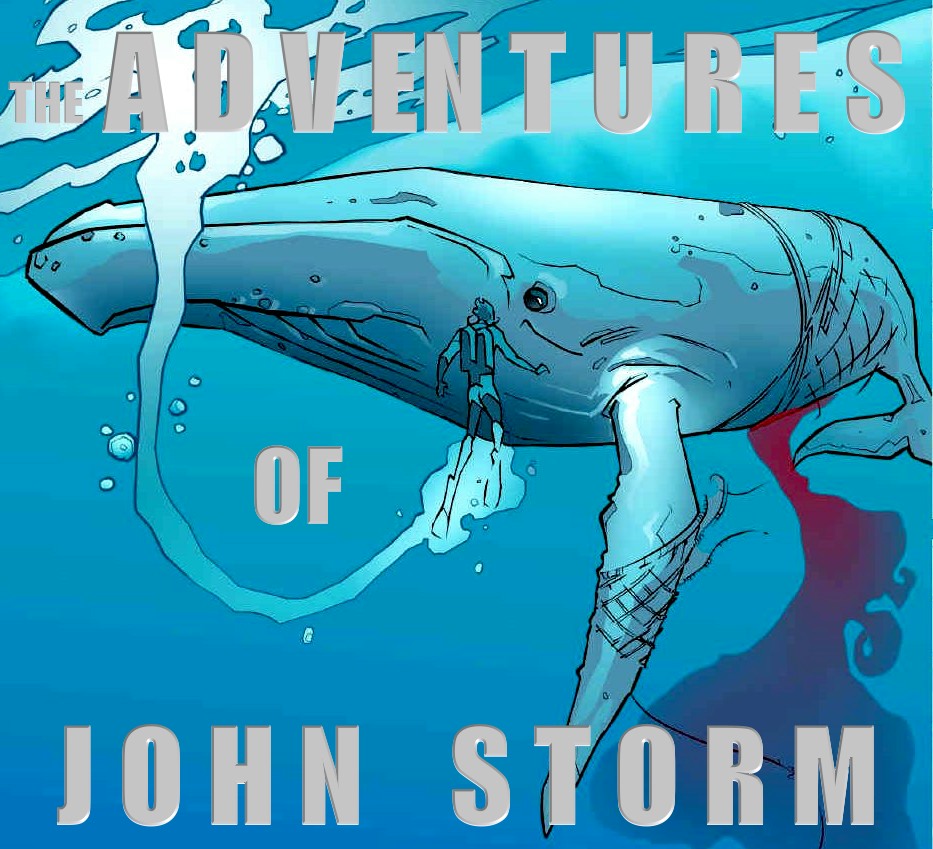
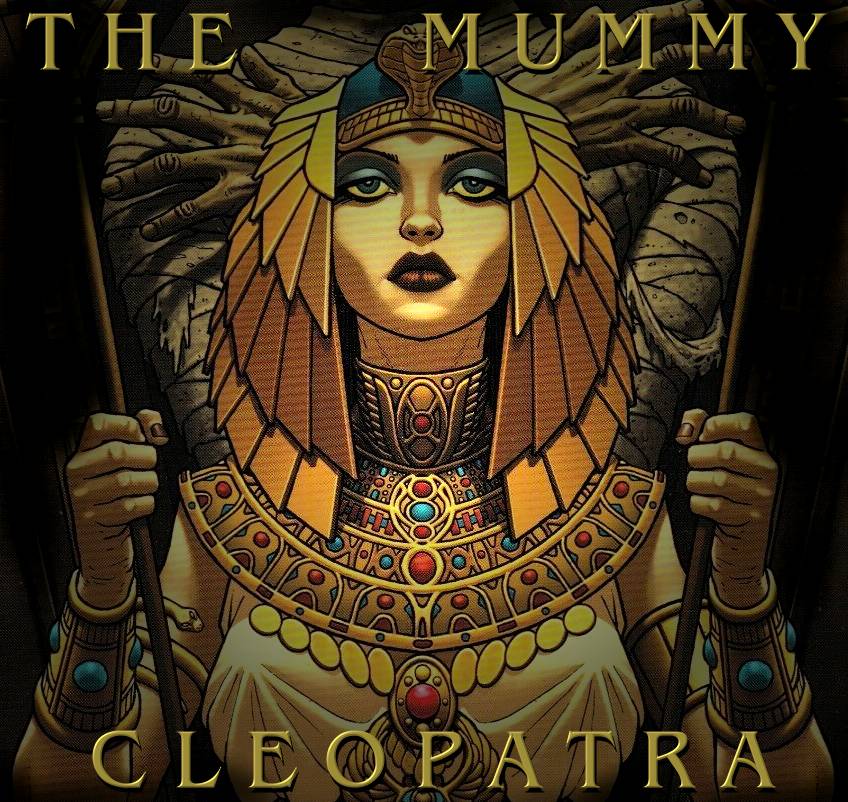
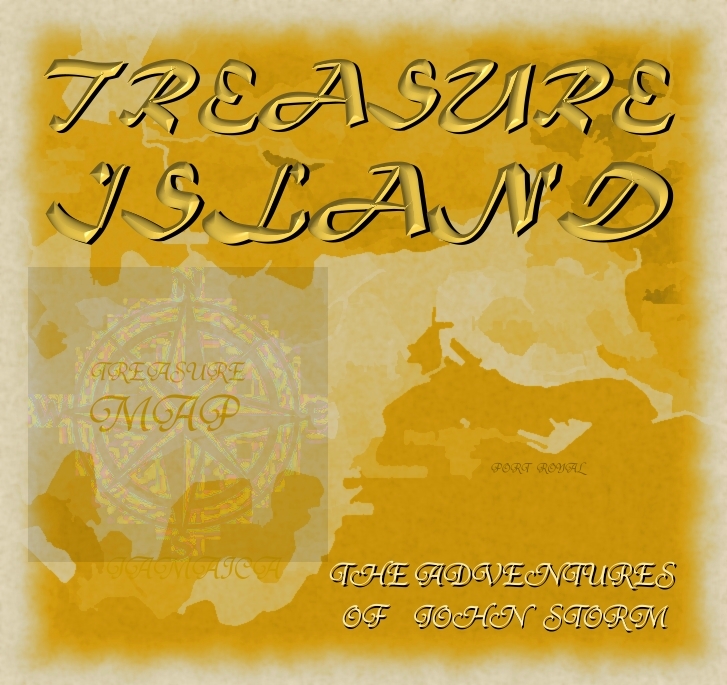
The
'John Storm' franchise, is a series of original stories being developed as
scripts & graphic novels, featuring the amazing solar & hydrogen powered Elizabeth
Swann ship, and her rugged ocean conservationist Captain, who is obsessive
about his DNA collection. These movies could be made back
to back, to help offset the more philanthropic (less box office lucrative)
Kulo-Luna.
Scripts available on request.
|











